Day: February 24th, 2008
Pinch & S’MAC
At Pinch & S’MAC on Columbus – a punny collaboration between the now-closed Pizza by the Inch and the East Village Sarita’s Macaroni & Cheese, the mac n’ cheese emporium which last year earned the Oprah stamp of approval on “Gayle’s New York Minute.”
Just as it had at its former Park Avenue South location, Pinch offers thin pies in four-inch widths, sold by length in four-inch increments, with choice of toppings. Personally I couldn’t say how their product stacks up against the offerings in a city full of superlative pizza, though they did seem to have a following. (Incidentally, Arthur Avenue’s Zero Otto Nove, which we visited a couple of weeks ago, was just named best in the Bronx by New York magazine.) The joining of these two cheese and carb forces is a coup, though, and last month’s opening of the Pinch & S’MAC joint venture, minutes’ walk from the Amsterdam Avenue frat bar scene, was met with considerable anticipation.
S’MAC offers variations on the cheesy pasta classic: from the “All American” (American and Cheddar – add seasoned ground beef to make it a “Cheeseburger” or sauced chicken pieces for the “Buffalo Chicken”) to more complicated, gourmet versions like the “Parisienne” (Brie, Figs, Roasted Shiitake Mushrooms and Fresh Rosemary) and the “Masala” (Cheddar and American cheeses, Tomatoes, Ginger, Onions, Cilantro, Cumin & Indian Spices.) Alternatively, you can pick any combination of offered toppings to customize your own dish. The elbow macaroni is served in cast-iron skillets of varying sizes — Nosh, Major Munch, Mongo and Partay! – with decent crust on top, but overall a bit soupy for my tastes. Breadcrumb topping optional.
The “Napoletana” (Fresh Mozzarella, Roasted Tomatoes, Roasted Garlic and Fresh Basil) — better in theory, perhaps, than in execution:
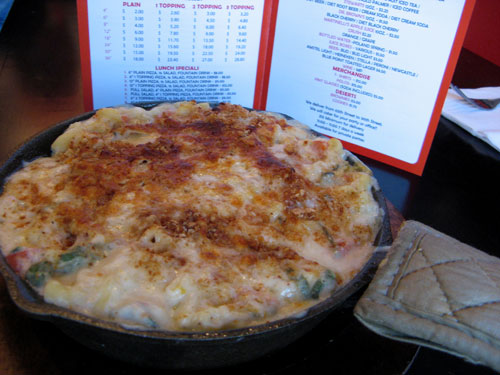
And the classic “All American”:
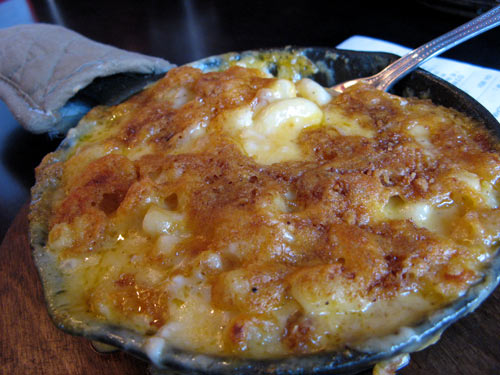
To me, mac n’ cheese is one of those comfort dishes that doesn’t require a lot of tinkering, so I would be partial to S’MAC’s American and Cheddar-based versions. In 2006, The Times’s Julia Moskin went in search of the ultimate home cook’s recipe, eventually foregoing the temptation towards fancier cheeses (Swiss Gruyère, Parmigiano-Reggiano, Italian fontina and Welsh Caerphilly) in favor of two straightforward cheddar-based recipes, divided into creamy and crusty preferences.
More wordplay across the street at West Side Wine. (No milkshake reference? I guess it’s over already.) The 80th Annual Academy Awards broadcast later that night, and would become the first since 1964 that all four main acting awards were won by non-Americans. That year, “Sexy Rexy” Harrison took home the Best Actor Oscar for his career-defining role as “Henry Higgins” in George Cukor’s screen adaptation of My Fair Lady. (The classic Lerner and Loewe musical is playing this week at MoMA as part of Sir Harrison’s “Centenary Tribute.”)
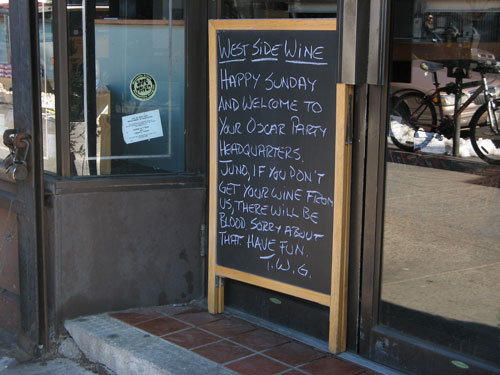
French star Marion Cotillard on her Oscar win: “I’m totally overwhelmed with joy and sparkles and fireworks and everything which goes like bom-bom-bom.”
What a charming sentiment!
Seneca Village
On a walking tour organized by the Central Park Conservancy this clear and chilly Sunday afternoon.
Our group of about a dozen met a pair of guides inside the Park at the Mariner’s Gate entrance at 85th Street. From there, we set off to tour the lands that once made up Seneca Village, Manhattan’s first known community of African American property owners. The village, founded in 1825, once occupied the land between what is now the Great Lawn to Central Park West and from 82nd to 89th Streets — an area of about five acres. Within a few years, the community developed into a stable settlement of over 250 working-class residents, with its own churches, school and cemetery. African Americans owned more than half the households in the village — an unusually high percentage of property ownership for any New York community. By the 1840s, Irish and German immigrants, and perhaps Native Americans, owned several land plots as well; in total, during its over three decades in existence, approximately 1,600 people owned property, lived and/or worked in Seneca Village.
Up the trail to Summit Rock — at 141.8 feet, the highest elevation in Central Park (but not the highest point in Manhattan.)
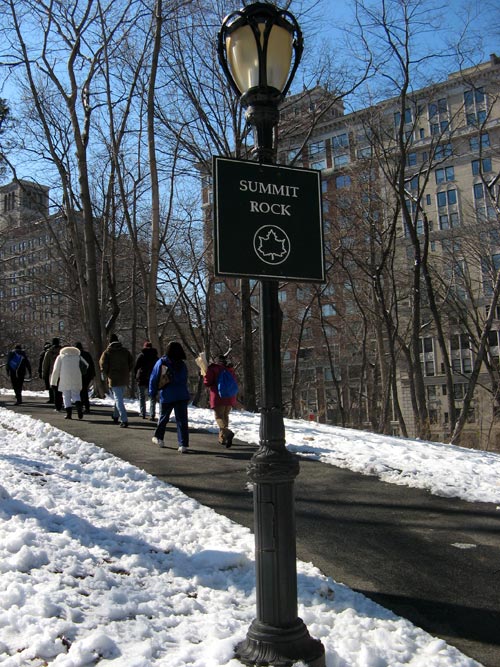
The guides explained the challenges of this particular park tour, as nothing of note remains of the original community, save for the trickling remnants of an abundant natural spring near 82nd Street which would have served as the village’s main source of fresh drinking water. Instead, we were given photocopies of historic maps, and shown artists’ renderings of the structures that would have existed in the mid-19th century. This view overlooks what would have been the heart of Seneca Village.
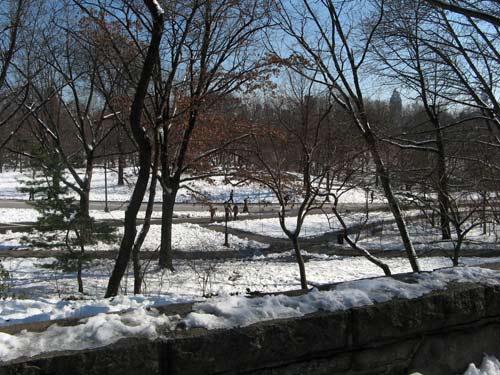
In 1855, the New York State Census reported approximately 264 residents in the semi-rural village, at a time when most of the city’s immigrant population was concentrated in slums below 14th Street. Two years later, after the state legislature authorized the use of eminent domain to publicly acquire private land for the purpose of creating Central Park, the entire village was razed without a trace. Landowners living within the boundaries of the proposed park were compensated financially for their property, though several filed claims in New York State Supreme Court, protesting the city’s valuations of their land. Little is known of the outcome of those lawsuits, or where the hundreds of residents may have relocated. What is known is that once scattered, the community of Seneca Village was not re-established.
This spot of red is a cardinal, hidden among the trees:

Winterdale Arch at 82d Street, a pedestrian underpass and bridle path. The 1994 restoration included the award-winning recreation of the original cast-iron fencing along the top of the arch:
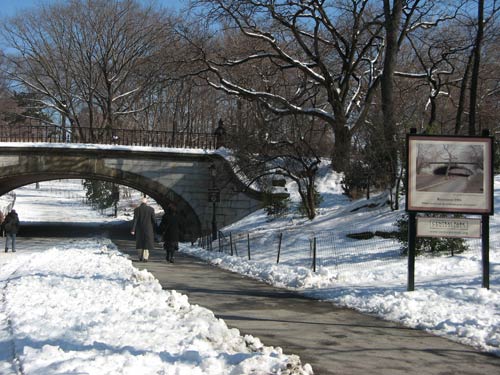
Search
Popular Tags
Categories
Archive
- July 2010
- July 2009
- January 2009
- November 2008
- September 2008
- August 2008
- July 2008
- June 2008
- May 2008
- April 2008
- March 2008
- February 2008
- January 2008
- December 2007
- November 2007
- October 2007
- September 2007
- August 2007
- July 2007
- June 2007
- May 2007
- April 2007
- March 2007
- February 2007
- January 2007
- December 2006
- November 2006
- October 2006
- September 2006
- August 2006
- July 2006
- June 2006